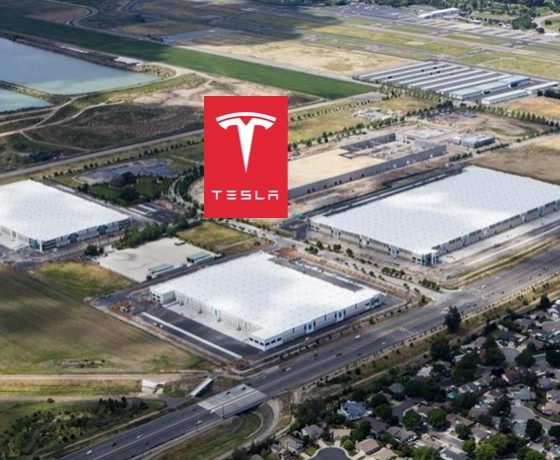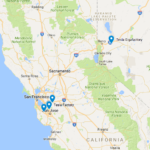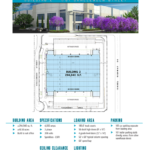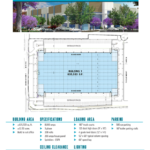

News
Tesla expands warehouse ahead of Model 3, signs largest industrial lease in area history
Tesla has inked a deal to lease three warehouses totaling a massive 1.3 million square feet in the Oaks Logistics Center in Livermore, California, just 20 miles northeast of the Fremont factory. The deal is being billed as the largest industrial lease signed in San Francisco East Bay history.
The deal comes at a critical time for the Silicon Valley-based electric car company, as it prepares for Model 3 production and readies to face one of the largest growth phases in the company’s history.
WATCH: Elon Musk shares video of Model 3 ‘Release Candidate’ accelerating down a street
CEO Elon Musk has regularly expressed concerns about running out of space at the company’s factory in Fremont, California. By having a new Tesla Warehouse that’s roughly 25% the size of the factory, the company can expand manufacturing and logistical operations in support of high volume production of Model 3.
The Oaks Logistic Center is a new facility that was constructed from 2014-2015 and is comprised of three separate warehouses ranging from 295,000 square feet to 634,000 square feet in size. Tesla signed a deal to lease two of the three warehouses last year, but will now take over the entire facility. The location sits strategically located just 20 miles northeast of the Fremont factory and in the direction of Tesla’s Gigafactory. As such, it could easily serve as a staging point for battery packs and other components coming into Fremont from Gigafactory 1.
- Tesla Gigafactory flyover March, 2017 [Source: NMGroup]
New aerial photos of Gigafactory 1 taken on March 17, 2017
The new state-of-the-art Tesla Warehouse facility has easy access to Highway 84 and Interstate 580, the Port of Oakland and the Livermore Municipal Airport. The location is also just across town from the Lawrence Livermore National Laboratory which focuses on energy as one of the key areas of research.
In line with Tesla’s desire to minimize the manufacturing footprint for Tesla products, all three buildings in the new property are LEED Silver certified.
A job posting for a Production Control Materials Analyst role at the Tesla Warehouse indicates that, “This position requires a blend of skills and experience that are specifically focused on the inventory management of several hundred manufacturing parts.” The individual will be responsible for “executing inventory control measures to ensure company minimizes stock holding and maximizes inventory systems” reads the job requirement.
Details for Tesla’s Warehouse are as follows, courtesy of BizJournals:
INDUSTRIAL – Tesla at Oaks Logistics Center
Location: 201 Discovery Drive,
801 Challenger St., and 800 Atlantis St., Livermore
Size: 1.3 million square feet
Tenant: Tesla
Landlord: Trammell Crow Co. and partner Bentall Kennedy
Developer brokers: Robert Ferraro and Blake Rasmussen of CBRE and Michael Lloyd of Colliers
Rent: $8.9 million per year reported

News
Tesla starts showing how FSD will change lives in Europe
Local officials tested the system on narrow country roads and were impressed by FSD’s smooth, human-like driving, with some calling the service a game-changer for everyday life in areas that are far from urban centers.

Tesla has launched Europe’s first public shuttle service using Full Self-Driving (Supervised) in the rural Eifelkreis Bitburg-Prüm region of Germany, demonstrating how the technology can restore independence and mobility for people who struggle with limited transport options.
Local officials tested the system on narrow country roads and were impressed by FSD’s smooth, human-like driving, with some calling the service a game-changer for everyday life in areas that are far from urban centers.
Officials see real impact on rural residents
Arzfeld Mayor Johannes Kuhl and District Administrator Andreas Kruppert personally tested the Tesla shuttle service. This allowed them to see just how well FSD navigated winding lanes and rural roads confidently. Kruppert said, “Autonomous driving sounds like science fiction to many, but we simply see here that it works totally well in rural regions too.” Kuhl, for his part, also noted that FSD “feels like a very experienced driver.”
The pilot complements the area’s “Citizen Bus” program, which provides on-demand rides for elderly residents who can no longer drive themselves. Tesla Europe shared a video of a demonstration of the service, highlighting how FSD gives people their freedom back, even in places where public transport is not as prevalent.
What the Ministry for Economic Affairs and Transport says
Rhineland-Palatinate’s Minister Daniela Schmitt supported the project, praising the collaboration that made this “first of its kind in Europe” possible. As per the ministry, the rural rollout for the service shows FSD’s potential beyond major cities, and it delivers tangible benefits like grocery runs, doctor visits, and social connections for isolated residents.
“Reliable and flexible mobility is especially vital in rural areas. With the launch of a shuttle service using self-driving vehicles (FSD supervised) by Tesla in the Eifelkreis Bitburg-Prüm, an innovative pilot project is now getting underway that complements local community bus services. It is the first project of its kind in Europe.
“The result is a real gain for rural mobility: greater accessibility, more flexibility and tangible benefits for everyday life. A strong signal for innovation, cooperation and future-oriented mobility beyond urban centers,” the ministry wrote in a LinkedIn post.
News
Tesla China quietly posts Robotaxi-related job listing
Tesla China is currently seeking a Low Voltage Electrical Engineer to work on circuit board design for the company’s autonomous vehicles.

Tesla has posted a new job listing in Shanghai explicitly tied to its Robotaxi program, fueling speculation that the company is preparing to launch its dedicated autonomous ride-hailing service in China.
As noted in the listing, Tesla China is currently seeking a Low Voltage Electrical Engineer to work on circuit board design for the company’s autonomous vehicles.
Robotaxi-specific role
The listing, which was shared on social media platform X by industry watcher @tslaming, suggested that Tesla China is looking to fill the role urgently. The job listing itself specifically mentions that the person hired for the role will be working on the Low Voltage Hardware team, which would design the circuit boards that would serve as the nervous system of the Robotaxi.
Key tasks for the role, as indicated in the job listing, include collaboration with PCB layout, firmware, mechanical, program management, and validation teams, among other responsibilities. The role is based in Shanghai.
China Robotaxi launch
China represents a massive potential market for robotaxis, with its dense urban centers and supportive policies in select cities. Tesla has limited permission to roll out FSD in the country, though despite this, its vehicles have been hailed as among the best in the market when it comes to autonomous features. So far, at least, it appears that China supports Tesla’s FSD and Robotaxi rollout.
This was hinted at in November, when Tesla brought the Cybercab to the 8th China International Import Expo (CIIE) in Shanghai, marking the first time that the autonomous two-seater was brought to the Asia-Pacific region. The vehicle, despite not having a release date in China, received a significant amount of interest among the event’s attendees.
Elon Musk
Elon Musk and Tesla AI Director share insights after empty driver seat Robotaxi rides
The executives’ unoccupied tests hint at the rapid progress of Tesla’s unsupervised Robotaxi efforts.

Tesla CEO Elon Musk and AI Director Ashok Elluswamy celebrated Christmas Eve by sharing personal experiences with Robotaxi vehicles that had no safety monitor or occupant in the driver’s seat. Musk described the system’s “perfect driving” around Austin, while Elluswamy posted video from the back seat, calling it “an amazing experience.”
The executives’ unoccupied tests hint at the rapid progress of Tesla’s unsupervised Robotaxi efforts.
Elon and Ashok’s firsthand Robotaxi insights
Prior to Musk and the Tesla AI Director’s posts, sightings of unmanned Teslas navigating public roads were widely shared on social media. One such vehicle was spotted in Austin, Texas, which Elon Musk acknowleged by stating that “Testing is underway with no occupants in the car.”
Based on his Christmas Eve post, Musk seemed to have tested an unmanned Tesla himself. “A Tesla with no safety monitor in the car and me sitting in the passenger seat took me all around Austin on Sunday with perfect driving,” Musk wrote in his post.
Elluswamy responded with a 2-minute video showing himself in the rear of an unmanned Tesla. The video featured the vehicle’s empty front seats, as well as its smooth handling through real-world traffic. He captioned his video with the words, “It’s an amazing experience!”
Towards Unsupervised operations
During an xAI Hackathon earlier this month, Elon Musk mentioned that Tesla owed be removing Safety Monitors from its Robotaxis in Austin in just three weeks. “Unsupervised is pretty much solved at this point. So there will be Tesla Robotaxis operating in Austin with no one in them. Not even anyone in the passenger seat in about three weeks,” he said. Musk echoed similar estimates at the 2025 Annual Shareholder Meeting and the Q3 2025 earnings call.
Considering the insights that were posted Musk and Elluswamy, it does appear that Tesla is working hard towards operating its Robotaxis with no safety monitors. This is quite impressive considering that the service was launched just earlier this year.














